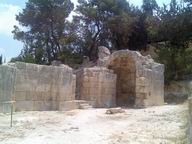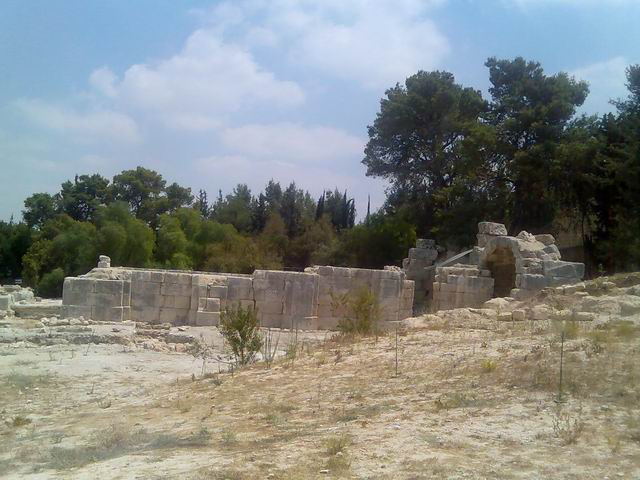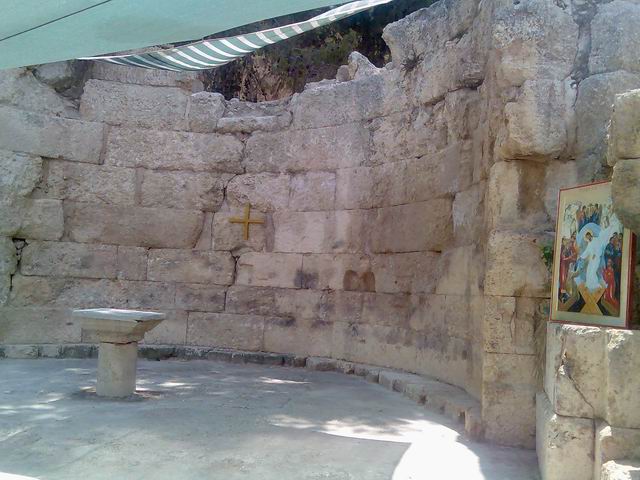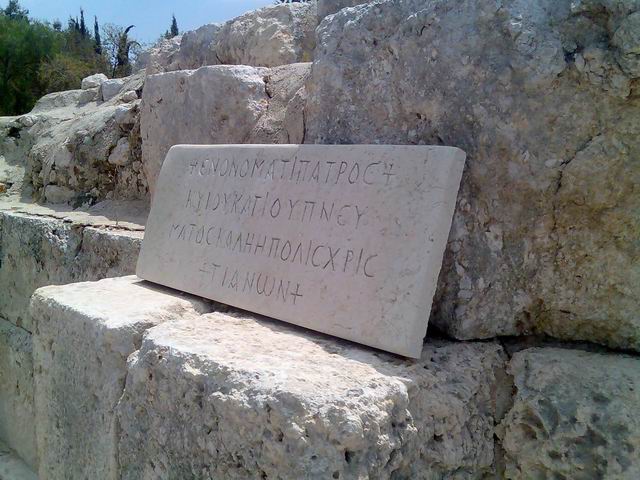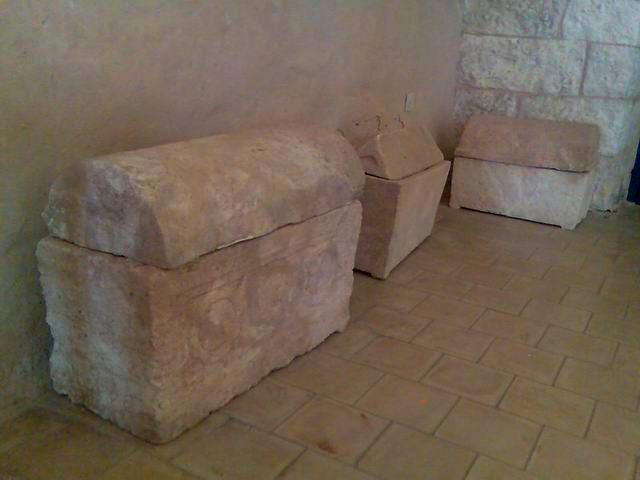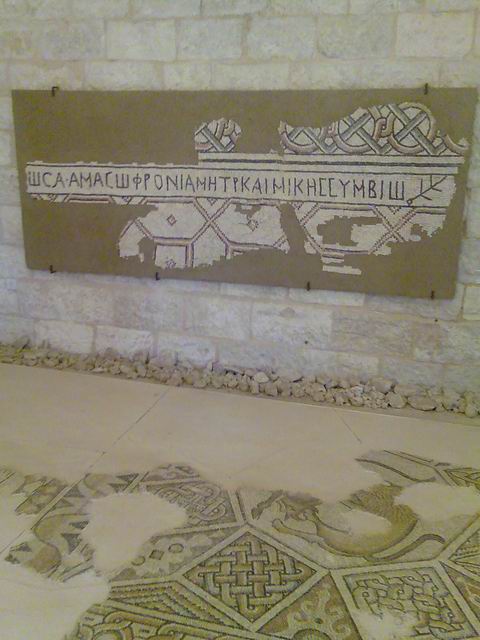The site is situated on the beginning of the road that climbs up to Jerusalem. It is believed to be the site of the village where Jesus, after resurrection, said farewell to Cleophas and his companion.
Home > Sites > Judea > Emmaus (Nikopolis) > Basilica
Contents:
Location
History
Photos
* Aerial views
* Church
* Museum
Visit
Biblical
Etymology
Links
Identification of Emmaus:
This place is believed to be the site of the village of Emmaus, which is referred in the Gospel of Luke (Chapter 24). This Gospel tells about the meeting between Jesus, after his resurrection, and the two companions, on the road to Emmaus.
There are different Biblical versions of the location of the village; some indicate sixty stadia (about 10KM) or hundred and sixty stadia (about 32KM). The latter version fits this location, which has additional characteristics that make it a better fit for the village.
Map / Aerial view:
The site is located 30KM west of Jerusalem, near the Latrun junction.
An aerial photo of the area is seen below, indicating the major points of interest.
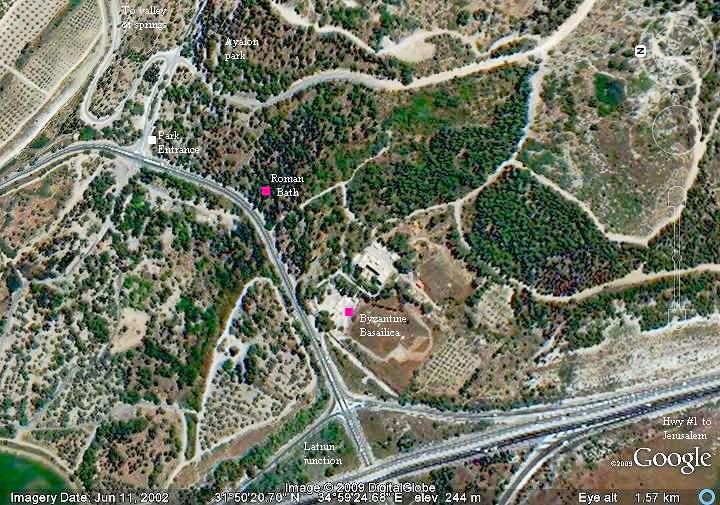
History:
- Brief history:
- 4th-7th century AD – Two Churches and cruciform baptistery are built here
- 638 AD – Arabs capture the city; transform it to Amwas, a district city
- 639-640 AD – Great Plague leads to evacuation of the city
- 6/6/1099 AD – Crusaders capture the site on the way to Jerusalem;
- – later they build a new church (restoring the Byzantine Church)
- 1838, 1852 AD – Explorer Robinson revisits and reports on the ruins of Emmaus
- 1924-1930 AD – Archeological digs unearth the site
- Madaba map
Emmaus is illustrated as an icon on the 6th Century Madaba mosaic map found in the floor of a Byzantine Church in Jordan. Above the icon is the Greek word “NIKOΠOΛIC” (Nikopolis), the Greek name of the city.
The icon shows a walled city with towers and gates, a central basilica and two churches.
Part of Madaba Map
Photos:
(a) Aerial views
An aerial view of the ruined Churches area was captured from the west side by a drone on July 2017. In the complex are ruins of two Byzantine period churches – the large southern church (seen here in the center), and the smaller northern church which was leveled (on the left side).
Click on the photos to view in higher resolution…
Another aerial view of the ruined Church was captured by a drone from the south side, focusing on the southern church.
The plan of the southern Church is a three apsidal Basilica, which is typical to Byzantine churches. In the 12th century, 5 centuries after its destruction, the Crusaders restored the ruins of the original church, rebuilding it on a smaller scale.
The major points of interest are indicated on this southern view.
(b) Southern Church
The following photo shows the archaeological site of Emmaus, where the remains of the southern Crusaders Basilica (12th century) stands over the 5th-7th century Byzantine Church.
The main apse of the southern Church is seen in the following photo:
A slab of marble from the Byzantine period with the Greek inscription: “in the Name of the Father, the Son and the Holy Spirit”. Beautiful, the city of the Christians Is”. This is a copy of the finding in the archaeological dig at this site.
(c) Museum
There is a Museum nearby with different archaeological artifacts. The following photo shows a set of ossuaries from Jewish tombs found in nearby Emmaus (1st century BC to 1st century AD).
A set of mosaics is also on display:
Visit at the site:
(a) Getting there
Drive to the site on Highway #1, 30KM west of Jerusalem, and exit on the Latrun junction and turn north.
The entrance to Emmaus-Nikopolis archaeological site is just a few hundred meters North from the junction.
(b) Ayalon Park
Other remains of the ancient city of Emmaus can be seen in the Ayalon “Canada” Park which is a few hundred meters past the entrance. They are located in the El-Aqed hill and the “valley of the Springs” in the park.
(c) Latrun Monastery
Another interesting site is the Latrun Monastery, which is just south of the highway. It is also known as the Monastery of Silence, which was founded in 1890 by a group of monks from Trappes (France). The Monks here used to avoid talking except for prayers, hence the name. It is famous also for its good wine and olive oil, sold at reasonable prices in the local store. A charming church is located at the place.
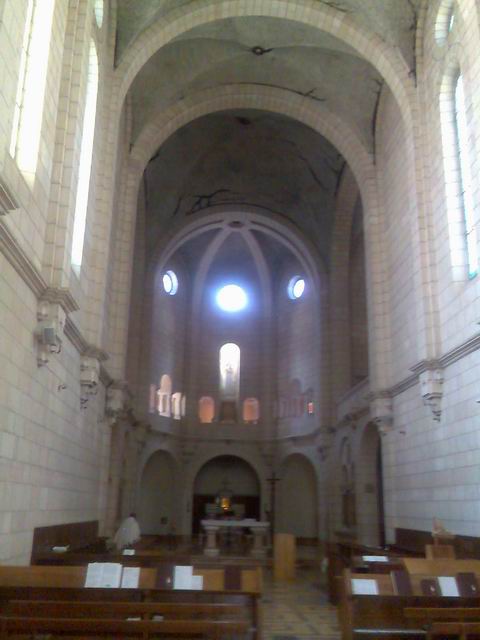
Biblical References:
Luke 24: 13-35 (King James version)
This text tells about the meeting between Jesus, after his resurrection, and the two companions, on the road to Emmaus.
“And, behold, two of them went that same day to a village called Emmaus, which was from Jerusalem about threescore furlongs. And they talked together of all these things which had happened. And it came to pass, that, while they communed together and reasoned, Jesus himself drew near, and went with them. But their eyes were holden that they should not know him. And he said unto them, What manner of communications are these that ye have one to another, as ye walk, and are sad? And the one of them, whose name was Cleopas, answering said unto him, Art thou only a stranger in Jerusalem, and hast not known the things which are come to pass there in these days?
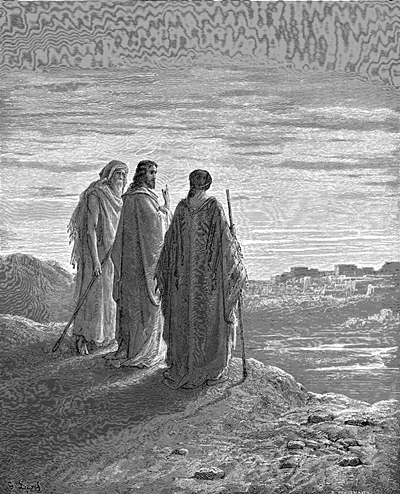
Walk to Emmaus – Drawing by Gustav Dore (French artist, 1832-1883)
And he said unto them, What things? And they said unto him, Concerning Jesus of Nazareth, which was a prophet mighty in deed and word before God and all the people: And how the chief priests and our rulers delivered him to be condemned to death, and have crucified him. But we trusted that it had been he which should have redeemed Israel: and beside all this, to day is the third day since these things were done. Yea, and certain women also of our company made us astonished, which were early at the sepulchre; And when they found not his body, they came, saying, that they had also seen a vision of angels, which said that he was alive. And certain of them which were with us went to the sepulchre, and found it even so as the women had said: but him they saw not. Then he said unto them, O fools, and slow of heart to believe all that the prophets have spoken: Ought not Christ to have suffered these things, and to enter into his glory? And beginning at Moses and all the prophets, he expounded unto them in all the scriptures the things concerning himself. And they drew nigh unto the village, whither they went: and he made as though he would have gone further. But they constrained him, saying, Abide with us: for it is toward evening, and the day is far spent. And he went in to tarry with them. And it came to pass, as he sat at meat with them, he took bread, and blessed it, and brake, and gave to them. And their eyes were opened, and they knew him; and he vanished out of their sight. And they said one to another, Did not our heart burn within us, while he talked with us by the way, and while he opened to us the scriptures? And they rose up the same hour, and returned to Jerusalem, and found the eleven gathered together, and them that were with them, Saying, The Lord is risen indeed, and hath appeared to Simon. And they told what things were done in the way, and how he was known of them in breaking of bread”.
Etymology (behind the name):
- Ham – warm in Hebrew.
- Hammat/Hammath – the Hebrew name of the city, based on its hot springs.
- Emmaus – the name of the city in Greek, based on the Hebrew name, and means hot springs. Another spa city, called “Emmaus of Galilee” , is located near Tiberias.
Links:
- The Community of the Beatitudes (entrusted to the care and upkeep of the site): http://www.beatitudes.org
- Emmaus-Nicopolis web site
Other BibleWalks web pages of Emmaus:
* Other internal links:
- Quadcopter Aerial views – collection of Biblical sites from the air
BibleWalks.com – gateway to the sites of Biblical Israel
Emmaus (Overview) <<<—previous site—<<< All Sites >>>— next Judea site—>>> Emmaus Roman Bath
This page was last updated on July 14, 2017 (Added aerial views)
Sponsored links:
